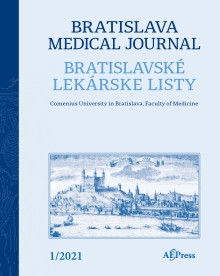Journal info
|
||||
Select Journal
Journals
Bratislava Medical Journal 2024 2023 2022 2021 2020 2019 2018 2017 2016 2015 2014 2013 2012 Ekologia - Ecology Endocrine Regulations General Physiology and Biophysics Neoplasma Acta Virologica Studia Psychologica Cardiology Letters Psychológia a patopsych. dieťaťa Kovove Materialy-Metallic Materials Slovenská hudba 2025Webshop Cart
Your Cart is currently empty.
Info: Your browser does not accept cookies. To put products into your cart and purchase them you need to enable cookies.
Bratislava Medical Journal Vol.121, No.12, p.835–839,2020 |
||
| Title: The comparison of modified minimally invasive and open surgical approaches in the treatment of epithelial thymic tumours | ||
| Author: P. Juhos, M. Janik, M. Lucenic, K. Tarabova, M. Komarc | ||
| Abstract: OBJECTIVES: Exploring the efficacy of a modified combined minimally invasive approach in patients with thymoma regardless of myasthenia gravis involvement in contrast to open surgery as the mainstay of treatment. BACKGROUND: Primary epithelial thymic tumours are rare malignancies of the anterior mediastinum, often present with myasthenia gravis, and with good prognosis when assuming complete surgical resection. We present a modified mini-invasive technique (MIT) that is unique in its extent. METHODS: Fifty-two patients were included in this retrospective study. Two groups of patients who had undergone different types of surgery were compared using the Mann-Whitney test (ordinal variables) and Fisher’s exact test (binary variables). Changes after completing the surgical learning curve were observed. RESULTS: There was a statistical difference when comparing early Masaoka stages (I‒II) with later stages in favour of the mini-invasive method (p=0.013). The duration of surgery was longer in the mini‑invasive group with a median value of 260 vs 133 min (p=0.001). The analysis of operation times revealed that after overcoming the learning curve period, the duration of surgery decreased (2008‒2012: 297 min; 2013‒2018: 199 min; p=0.005). The systemic complication rate was lower in the mini‑invasive method (26.1 % vs 3.4 %; p=0.035). CONCLUSION: Our results showed the modified maximal minimally invasive thymectomy to be an effective and safe method, and after overcoming the learning curve, even superior to open surgery in cases with lower tumour stages in terms of its extent (Tab. 3, Fig. 1, Ref. 49). |
||
| Keywords: thymoma, thymic carcinoma, myasthenia gravis, minimally invasive surgery, VATS, thymectomy | ||
| Published online: 09-Dec-2020 | ||
| Year: 2020, Volume: 121, Issue: 12 | Page From: 835, Page To: 839 | |
| doi:10.4149/BLL_2020_137 |
||
|
|
 download file download file |
|

